Living and traveling in Korea

A Guide To Gyeongju, Korea: What To Do, See, Eat & Where To Stay
If you haven’t heard of Gyeongju, Korea yet, then you need to! Though Andong, Korea is often referred to as the most traditional city in the country, I’d say that Gyeongju is the most historical you can visit. Gyeongju is referred to as “the museum without walls” because everywhere you turn you can find another site with historical relevance to see. The city actually has more tombs, temples, pagodas, palace ruins, and other historical artifacts than any other place in Korea. I’d say it’s a must see, but that term is so overused at this point.

I visited Gyeongju for the first time over a decade ago and found it to be so amazing. To have so much history in one area is inspiring. I went back recently and found it to be just as inspiring and now even romantic in a way. Walk down small streets and turn corners to find beautiful old forests and pagodas peeking through or see tombs and bridges. It really is a beautiful city that you could and maybe should visit again and again.
Want to skip around? Here is what you can find in this post:
What You Need To Know
Public transportation, join a tour, where to stay in gyeongju, daereungwon tomb complex / tumuli park (대릉원경주시 사적공원), cheomseongdae observatory (첨성대), woljeonggyo bridge (월정교), gyochon traditional village (교촌한옥마을), donggung palace & wolji pond (동궁과 월지), national museum of gyeongju, bulguksa temple & seokguram grotto (불국사 & 석굴암 석굴), gyeongju tower in gyeongju expo park, gyeongju namsan mountain / gyeongju national park, traditional market tour & cooking class, gyeongju world amusement park, roller skating & cm sports, retro school uniform rental/ hanbok rental, what to eat in gyeongju.
(This post contains affiliate links, which means I receive a certain percentage of a sale if you purchase after clicking at no cost to you. Thank you for your support.)
Gyeongju Itinerary

Located in Gyeongsangbuk-do, Gyeongju was the capital during the Silla dynasty which reigned for almost 1000 years from 57BC until 935AD. At the time, Gyeongju was the fourth largest city in the WORLD. Let that sink in for a moment… the world. There were fifty-six kings or queens which ruled during the period. The city is now like a living museum with historic sights around every corner not only from the Silla Dynasty and the kingdom’s lavish lifestyle but there are also numerous Buddhist relics to behold in the city.
In the 7th century, Mahayana Buddhism spread from China into Korea and architects and craftsmen were chosen to build temples and sculptures dedicated to Buddhism and you can find a ton here.
The city has a rather splendid history during the time of the Silla dynasty but as all dynasties come to an end, so did the Silla dynasty and when the Joseon dynasty came into power in 1392, the capital was moved to Seoul. Gyeongju suffered invasions during the Japanese colonization period and became one of bloodiest battlefields.
During the Joseon dynasty, Buddhists were chased up into the mountains and the beautiful sculptures had their arms and heads hacked off by Neo-Confucian radicals. When you’re out hiking, if you see a beheaded sculpture, look around for the heads. They’re often scattered nearby. Though the city lost its designation as a capital city, in 2000 it did gain distinction and was designated an UNESCO World Cultural Heritage site. It’s peaceful. It’s stunning. It’s fun.

How To Get To Gyeongju
By Train: If you’re traveling by train, look into purchasing the foreigner discount train pass to save money and get around to numerous cities via train (One stop you could make is at Gimcheon Station to take a ride on the longest and tallest zip wire in Korea!). From Seoul the easiest and most convenient way to get to Gyeongju is via the KTX. Direct trains are available from Seoul Station every hour and take between two hours and two and a half hours. The KTX train station in Gyeongju is actually located outside of the city center so you’ll have to catch a taxi or take a bus to your local stay most likely. We opted for the taxi and it took just 20 minutes and cost about W15,000.
By Bus: Take an express bus from Seoul to Gyeongju. The trip takes 3 and a half hours. You can usually rock up to Express Bus Terminal and get on a bus without issue, but if you want to book tickets in advance and ensure you have them, get your bus tickets through Trazy who can do the hard work for you.
By Train: If you’re in the central Busan area, then it would make the most sense to travel by train. You can choose between the KTX or the slow train. The KTX option runs every 30 minutes and takes about a half hour and costs around W12,000.
By Bus: If you’re in the northern Busan area, it would make more sense to travel via bus from Nopo Bus Terminal. There are buses that run every hour and they take about 45 minutes and cost around W5,000.
Join A Tour: If you’re in Busan, book a tour from the southern port city to Gyeongju. There are some great options that will get you up to Gyeongju and back again in a day and let you see a ton! This Klook tour picks up at three different spots in Busan and then stops at Yangdong Village, Bulguksa Temple, the tombs and Cheomseongdae Observatory and more and gets you back to Busan all in one day. You can also book a private driver who will pick you up in Busan and get you up to Gyeongju to see it all and back in your own time.
How To Get Around Gyeongju
T-Money card: If you’ll be using the buses and location transportation, make sure to have your T-Money card purchased and topped up. You can get around by local bus pretty easily as long as you’re prepared.
Gyeongju City Bus: Much like the other touristy cities in Korea, Gyeongju also has its very own tourist bus to take you to the must see spots. Check out the route and pick up a card here.
By Bike: There are numerous bike rental shops and kiosks around the city of Gyeongju. You can find them near express bus terminal and they rent by the day or for just a few hours. This is a great way to get around the historic sites. There’s also a pedibike service in the Gyochon Hanok Village near Woljeonggyo Bridge.
A Day In Gyeongju: If you’re looking to really learn about the cultural and historic sites that you’re visiting, definitely book a tour. Guides are knowledgeable and can answer any questions you have. This tour in Gyeongju makes stops at Bulguksa Temple, Cheomsangdae Observatory, Gyochon Hanok Village, and more. Get a guide and a ride easily to all of spots. Check out the Gyeongju day tour here .
Personally, I love driving especially if we’re outside of Seoul. We can stop whenever we want to and wherever we want to. If you’ve never looked into renting a car before, then maybe you should for this trip! KKDay makes it really easy if you have your International Driver’s License and passport or Korean Driver’s License and proof of insurance. You can get a KIA Ray, perfect for five passengers, for a steal at around $50.00. It’s definitely something to look into if you enjoy a good drive and planning on a whim. Check out the deals on KKDay for car rental in Gyeongju here.
Hyuhyudang is a gorgeous Hanok stay near the historical sites. The rooms are chic and decorated with stones and wooden accents. It’s a beautiful place to stay and unlike some of the other traditional Hanok houses in the village, features beds in the rooms for visitors to sleep on.
Check out this unique place on Booking.com
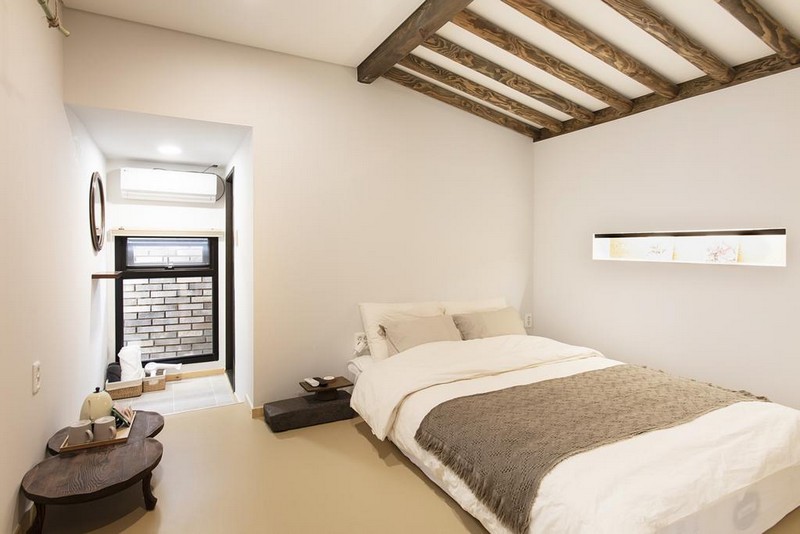
Gyeongju Happy Village Syeobul
Staying in a traditional Hanok house while visiting Gyeongju is a must. This Hanok house was built in 2015 and each room features its own private bathroom. Sleep on the warm heated floors making it cozy in the winter and comfortable in the summer. The family that owns the house is very friendly and helpful.
Check out this option on Booking.com or here on Agoda.com .
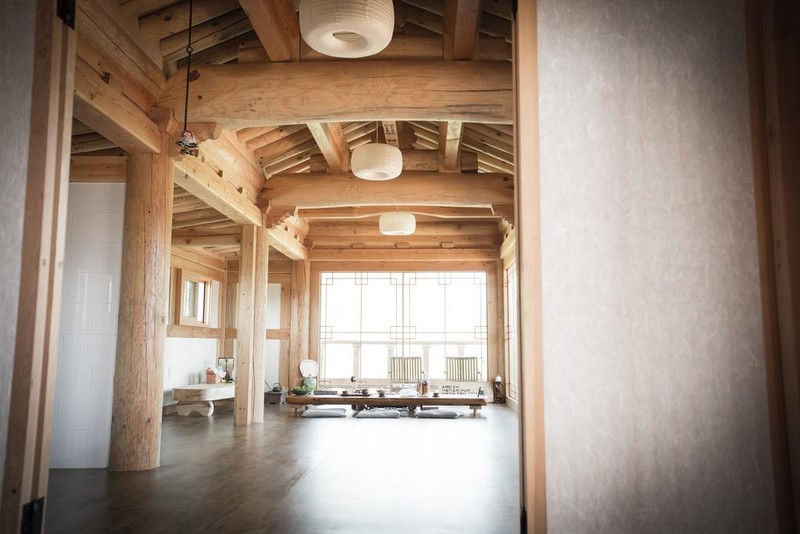
What To See In Gyeongju

The tombs in this complex are believed to have been built during the Silla period. When I first visited the complex in 2007, you couldn’t go inside any, but today, there is one tomb that has been opened through excavation and visitors can enter to see the interior.
In 1973, a crown and other relics were excavated from one mound known as Cheonmachong. The name was given to the mount because a flying horse was painted on a pendant of the saddle that was found inside. There are more than twenty tombs that are both small and large and house kings, queens and other court officials. Not all of the tombs have been identified yet though if you check out the signs, you can see who is buried in the ones they’ve excavated.
FYI: Climbing up the tomb is punishable with a 20 million won fine ($20,000.00) or a 2 year imprisonment.
- Address: Gyeongju-si Gyerim-ro 9 (경상북도 경주시 계림로 9)
- Hours: Every day: 9:00am ~ 10:00pm
- Admission: Adults: W3,000; Children 13-18: W2,000; Children 7-12: W1,000

Cheomseongdae Observatory was built during the reign of Silla Queen Seondeok from 632 to 647. It is the oldest astronomical observatory in East Asia. I remember reading this before I went and thought we’d see some amazingly huge observatory. It is not that, but considering the time period, it is actually rather spectacular.
The observatory is just 5.17 meters in diameter and 9 meters tall and was built using 365 stones representing the days of the year and has twelve stones that make up the base representing the months of the year. You can visit during the day and at night the observatory is lit up with varying colors for a lovely night time adventure.
- Address: 839-1 Inwang-dong, Gyeongju-si (경북 경주시 인왕동 839-1)
- Admission: Adults: W4,000; Children 13-18: W3,000; Children 7-12: W2,000

Though not as historical as some of the other sites in this list, this beautiful bridge is popular during both the day and the evening when it’s all lit up. Very close to the Gyochon Traditional Village, the bridge was constructed over five years and was finally opened in 2018.
There used to be a bridge in the same location but it was destroyed numerous times in history. It is still lovely to see and walk through and is a gorgeous spot to take photos. This is also lit up at night and is around the walking path from Cyochon Traditional Village and Cheomseongdae Observatory so definitely add it into the itinerary.
- Address: Gyeongju-si Gyo-dong 274 (경상북도 경주시 교동 274)
- Hours: 9:00am ~ 10:00pm
- Admission: FREE

Gyochon Traditional Village is where Korea’s first state-operated academy, Gukhak, was established in 682 under the rule of Silla King Sinmun. During the Goryeo Period between 918 to 1392 the academy was succeeded b Hyanghak and then became Hyanggyo during the Joseon Period between 1392 and 1910, thus the name of the village changed from Gyodong to Gyochon and then to Gyori. The village also once housed the royal palace famous for a love story between Princess Yoseok and great Silla monk Wonhyo.
Today, the village is famous for the wealthy family Choe which has seen twelve generations of the family over 400 years live and prosper in the area.
- Address: Gyeongju-si Gyo-dong 71 (경상북도 경주시 교동 71)

Donggung Palace is really all that remains from the Silla Kingdom’s huge palace complex as the palace was burnt to the ground in 935. Considered a secondary palace to the main, it was used by the crown prince. In the early 20th century archaeological excavations were carried out and the magnitude of the complex was rediscovered. In all, there were 26 buildings but only three have been reconstructed. The main palace complex wasn’t rebuilt so though there isn’t a ton to see here, there is a beautiful pond and some important relics to take in.
Wolji Pond is one of those relics and is a popular spot for people to visit in the evening when the lights come on and the sky becomes dark. Don’t be confused, Wolji Pond was previously known as Anapji Pond and was part of a palace complex that was constructed in 674. This artificial body of water was commissioned by King Munmu in 674 and served as a place of pleasure to celebrate the unification of the Korean peninsula during the Silla Kingdom period.
I’ve seen some really beautiful photos of this area in the spring with cherry blossoms blooming. Definitely check out going to Gyeongju in the spring if you want to find one of the best places to see cherry blossoms in Korea.
- Address: 102 Wonhwa-ro, Gyeongju (경상북도 경주시 원화로 102)
- Admission: Adults: W2,000; Children 13-18: W1,200; Children 7-12: W600
If you really want to dig in and learn more about the Silla Kingdom, definitely stop by the National Museum of Gyeongju. There is a substantial collection with 80,000 relics and artifacts including statues, jewelry, pottery, petroglyphs, crowns, and swords. Pieces are rotated and changed and at any one time 2500 pieces from the collection are on display.
Many of the relics, like the large Bell of King Seongdeok are located outside around the museum so if it’s a nice day even just taking a walk around the museum would be nice. Definitely check out the bell, by the way, because it’s the largest bell in Asia and is three meters high and 25 tons!
When I saw the bell the first time, it was actually in a different location but has since been moved to the National Museum of Gyeongju. The bell is commonly known as the Emile Bell which is an ancient Silla term for “mommy”. According to legend, the first bell that was cast produced no sound when struck so the bell had to be recast multiple times. Unsuccessful, the king that had wanted the bell cast past away and when the prince reigned, he continued in the effort to cast the bell. Still unable to make it ring, one night a monk had a dream that the bell would only ring if a child were cast into the metal so a child from the village was cast into the bell and finally the most beautiful sound came forth from the bell.
- Address: 186 Iljeong-ro, Gyeongju-si, Gyeongsangbuk-do (경상북도 경주시 일정로 186 (인왕동))
- Hours: Sunday – Friday: 9:00am ~ 6:00pm; Saturdays and National Holidays: 9:00 ~ 7:00pm* (*Saturdays in March – December: 9:00am ~ 9:00pm)
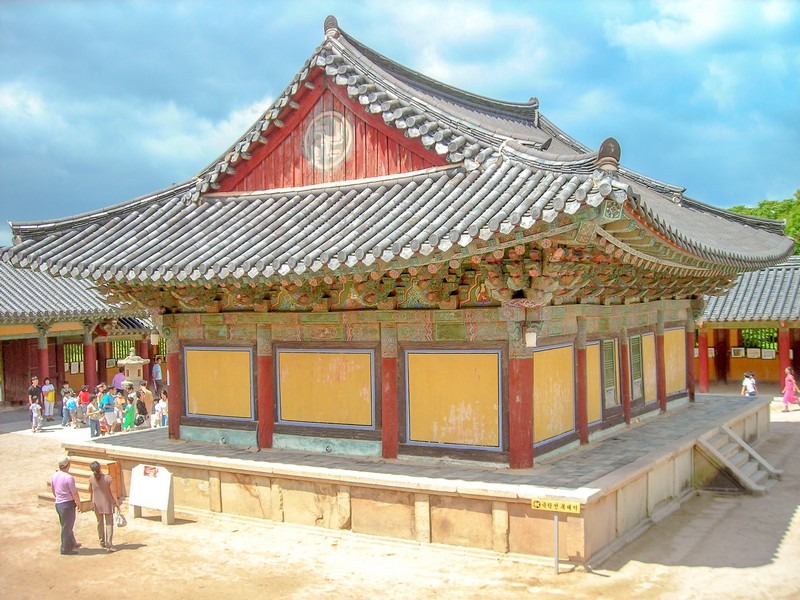
This huge working Buddhist temple was one of the first places we visited a decade ago. It’s one of the most impressive temples in Korea and is considered a masterpiece of Buddhist art. Built in the 8th century, it has been an UNESCO World Heritage site since 1995. Visit in the early morning or during the weekday if possible so there are less tourists and remember to be respectful and quiet as this is a working temple with Buddhists residing on the grounds. This temple is part of the Jogye order, the same order which contains Jogyesa temple in Seoul and the gorgeous Naksansa seaside temple in Gangneung.
Hike a couple kilometers up (about 30 minutes) from Bulguksa Temple and you’ll be able to see Seokguram Grotto. If hiking isn’t your thing, then take the #12 bus that departs from the parking lot every hour beginning at 8:40AM. The trip takes 20 minutes.
The grotto features a seated Buddha protected by twelve royal guards. If you visit on the solstice, you can witness the third-eye of the Buddha hit by a ray of the sun as it comes through the dome above the head of the statue. Photography is not permitted in the grotto due to its sacred nature.
- Address: Gyeongju-si Jinhyun-dong San-15 (경상북도 경주시 진현동 산15)
- Hours: November – January: 7:30am ~ 5:00pm; February: 7:30am ~ 5:30pm; March – September: 7:00am ~ 6:00pm; October: 7:00am ~ 5:30pm
- Admission: Adults: W5,000; Children 13-18: W3,500; Children 7-12: W2,500

Completed in 2007 to coincide with the Gyeongju Expo Culture Center, the Gyeongju Tower is really a stunning piece of design. While there are pagodas throughout the city, this building has the cutout of one which is just beautiful whether your visit by day or night when it’s lit from the interior. The tower is 82 meters tall which is similar to a 30 story apartment building.
We visited at night, but if you visit during the day, you can actually go up into the observation deck of the building. I’d recommend going during the day and then stay into the evening if possible as there is also a beautiful lotus pond in the expo park. During the summer the park also has a ton of roses to see. For more information, check out this guide to the Gyeongju Expo Park because there is a lot to do there.
- Address: 614 Gyeonggam-ro, Gyeongju-si, Gyeongsangbuk-do (경상북도 경주시 경감로 614)
- Hours: Every day: 9:00am ~ 6:00pm (The park is open later, but this is the time specified for the building itself.)
- Admission: Adults: W8,000
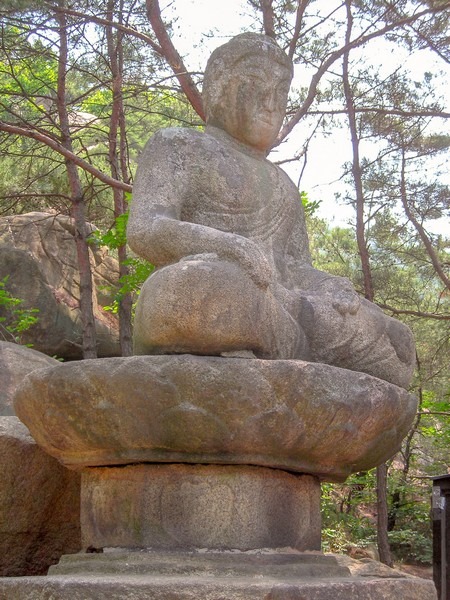
Hiking nearby Namsan Mountain is really not your average hike and is pretty incredible. Going along with how the city is a open air museum, the mountain truly is as well. With over 100 temples and 80 stone Buddha statues, there is a lot to be found. As you hike, you’ll discover Buddhist sculptures and many of them have been beheaded as I mentioned earlier.
It’s a great hike that wasn’t too difficult though there were some steep sections. There were tall grasses to walk through, hidden relics to be found and views to be had. It took us about four hours but there are various trails to choose from. Make sure to stop by the Tourist Information Center in town to get a map of the mountain and the hiking trails. We were a bit lost most of the way and just sort of hoped we’d get back and forth alright. We did, BUT if you want to have a guide and make sure you don’t miss the relics and get up and back in four hours without getting lost, there’s a great guide available on Airbnb . Check it out for your trip.

Cooking is one of the best ways to learn about a culture and have fun while you’re at it. Join a guide in a traditional market and then head out to cook a menu that includes an appetizer, main dish, dessert, and a beverage. The menu changes based on season and other conditions so check with the guide to see what will be made .
Maybe you want to mix it up and do something fun on your trip to Gyeongju. Gyeongju World Amusement Park is the largest theme park in the southern area and is most famous for the X-Zone which features the Phyton, Mega Drop, Tornado, Grand Canyon, King Viking, and Submarine Splash. Rollercoaster fan? Don’t miss this amusement park in summary. There’s also a great kid’s zone in Wizard Garden, water fun at California Beach in the summer and a large sledding zone in the winter. Get your tickets online from KKDay to take advantage of the discounts and easy to use QR code when heading in.
- Address: 544, Bomun-ro, Gyeongju-si, Gyeongsangbuk-do (경상북도 경주시 보문로 544 (천군동))
It’s been ages since I last skated, but if you’re looking for something fun to do with friends that’s a bit different from the cultural and historical sites, then definitely look into putting on some skates and taking to the floor to travel back into the 80s with some fun disco music. CM Sports Town has a spacious lounge and various facilities to enjoy. It’s a super fun activity to do with friends or kids.
There’s no time limit on roller skating so get out there! Roller skates in sizes 16cm – 30cm (190-300) are available along with protective gear including helmets, knee pads, elbow pads, and wrist guards.
- Address: 97-1 Gwangjung-gil Gyeongju-si Gyeongsangbuk-do (경북 경주시 광중길 97-1 (용강동 1228-41))
- Admission: Get your tickets online with KKDay before you go to get an awesome discount.
- Hours: Every day: 10:00am ~ Midnight
Visiting traditional and historical sites is only made better when there are historic and retro costumes to go along with it. Have some fun with your photos and rent clothes while you’re out and about. Hanboks are, of course, a beautiful addition in photos while retro school uniforms are a bit more quirky. There are also retro outfits like dresses and suits that are all the rage for rental in Seoul right now. Why not do it in Gyeongju too? Want some options? Here they are:
- Retro Outfit Rental: You can rent in two hour or four hour durations or for the entire day here with KKday .
- Retro School Uniform Rental: Check out this deal on KKday for hourly or daily rental .
- Hanbok Rental at Daereungwon Tomb Complex: You can choose from over 250 sets of Hanboks on site with varying patterns and styles. Check out the Hanbok options here on KKday.
Surprisingly, unlike most cities and small towns in Korea that promote some dish, side dish or dessert, Gyeongju isn’t really famous for any specific food.
Gyeongju Bread: Also called Hwangnam bread after the region it’s from, Gyeongju bread is a small pastry that is filled with red bean paste. It’s small and was first baked in 1939 in a bakery in central Gyeongju. While there are red bean pastries and breads all around Korea and you can spot them even at street food carts, the ones in Gyeongju can be spotted by the chrysanthemum that is imprinted in the top.
The government has designated this treat as an “outstanding regional specialty” but, to be honest, it’s not entirely different from other red bean baked goods I’ve found other places so have it because it’s cute, but know what you’re buying.
Beopju: If you’re interested in alcohol and production in Korea, then Beopju might strike a fancy. This clear rice wine, or cheongju, made by the head house of Gyerim Choe clan who reside in Gyeongju is renowned. First made by a Joseon official who was in charge of the royal kitchen, he returned home to Gyeongju and passed on the recipe to his descendants.
Today, the recipe is owned and produced by Bae Young-Shin the daughter-in-law married to the eighth generation grandson of Choe Gukjun and her oldest son Choe Gyeong.
Did you like this post? Pin It!
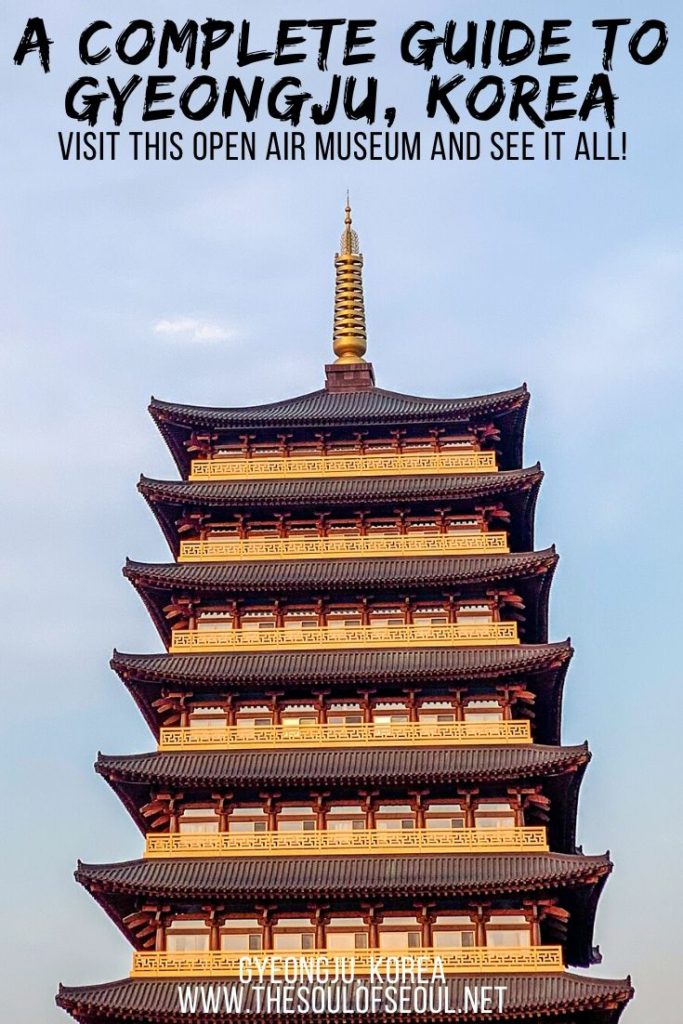
You May Also Like
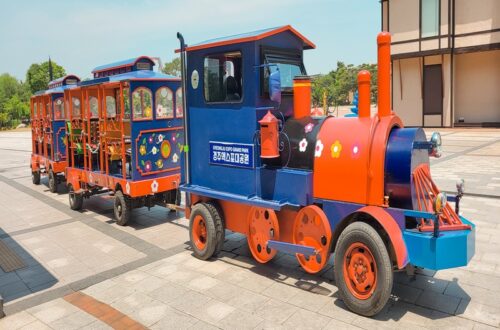
A Guide To the Gyeongju Expo Park

An Old Traditional Nobleman’s Home in Cheongsong, Korea
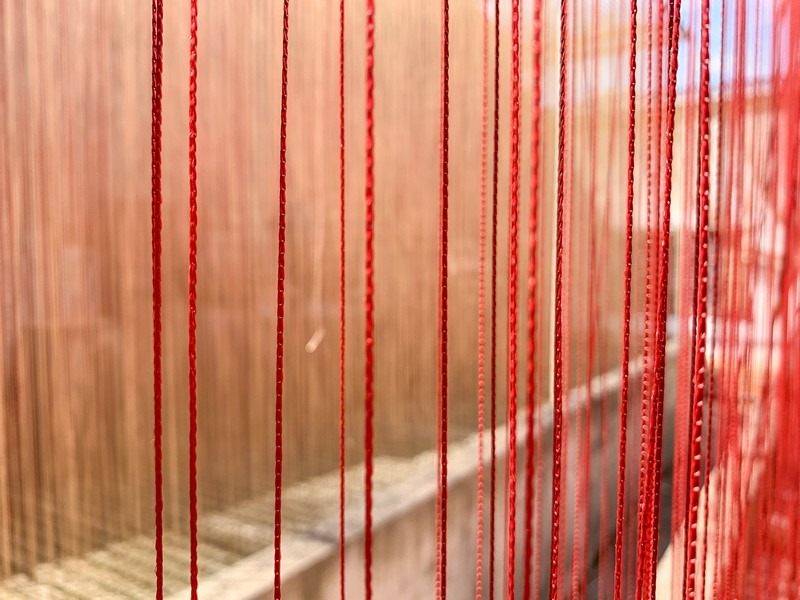
Off The Beaten Path In Korea: The Hamchang Art Road In Sangju
I’m so happy to have come across this post. We’re visiting SK in May and planning on visiting Gyeongju for 2 days in the middle of our trip to Seoul. I see that most attractions are open everyday so any day of the week so any day of the week should be okay to come? We’re taking the KTX. Would you recommend taking a car to get around visiting the attractions or the bus or take tours? Lastly, if you don’t mind, I booked a hotel for 2 nights instead of a Hanok because I’m afraid the chances of mosquitos is higher in a hanok. Is this true?
I appreciate all the details you’ve included in your post and very excited for our trip. Thank you for for any information you can give me about my questions. Have a great day!
Hallie Bradley
The KTX should be fine for Gyeongju since most of what you want to see is all in the same area. You can venture out a bit by bus or taxi which is pretty budget-friendly compared to most countries. May shouldn’t be bad for mosquitos yet so a Hanok would be fine. But if you’re more comfortable in a hotel, definitely go for that. I hope you have a great trip!
Thank you for the write-up on Gyeongju!
Can I check if it is possible to board a bus at the Haeundae Bus Terminal to Gyeongju Bus Terminal if I am planning to head from Busan to Gyeongju?
Yeah, it looks like there are buses from there so it shouldn’t be a problem.
Thank you for writing so comprehensively on Gyeongju which is of great help to my upcoming trip! Can I check with you on the recommended itinerary route for distance?
Do I follow exactly where you go so that its more “on the way”? Thankyou for your assistance in advanced! 🙂
Daereungwon Tomb Complex / Tumuli Park (대릉원경주시 사적공원) Cheomseongdae Observatory (첨성대) Woljeonggyo Bridge (월정교) Gyochon Traditional Village (교촌한옥마을) Donggung Palace & Wolji Pond (동궁과 월지) National Museum of Gyeongju Bulguksa Temple & Seokguram Grotto (불국사 & 석굴암 석굴) Gyeongju Tower in Gyeongju Expo Park Gyeongju Namsan Mountain / Gyeongju National Park
It really depends where you’re staying and starting from. I would suggest adding all of those spots to your own GPS map and then you can zig zag to the spots as you’re nearby. ^^
Thanks a lot for this post! I’m travelling in South Korea now and was looking for some info on Gyeongju. I found quite a few posts but yours was pretty informative, easy to understand and I like the fact that you added the addresses, the times, the prices but, also, the name of the places in Korean. Very useful when looking for it on a map!
Keep up the good work! 🙂
Absolutely. I try to make it as easy as possible! Over the years, I’ve gotten so many questions when it comes to those things and know exactly how hard it can be to navigate. All the easier with all of the relevant details though! Have a great adventure. ^^
Leave a Reply Cancel reply
Your email address will not be published. Required fields are marked *
Sign me up for the weekly updates newsletter!
This site uses Akismet to reduce spam. Learn how your comment data is processed .

- Accomodation
- Attractions
- Food & Drink
- K-Entertainment Tours
- Korean Culture
- Shopping Destinations
- Transportation
- Travel Essentials
- Travel Tips
- Travel News in Korea
- Gyeonggi-do
- North Gyeongsang (Gyeongsangbuk-do)
- North Jeolla (Jeollabuk-do)
- South Chungcheong (Chungcheongnam-do)
- South Gyeongsang (Gyeongsangnam-do)
- South Jeolla (Jeollanam-do)

Discover the Hidden Treasures of Gyeongju: Top 12 Must-Visit Spots

3,975 total views, 4 views today

Discover the best places to visit while you are in Gyeongju!
Steeped in rich history and brimming with natural beauty, Gyeongju is a travel destination that offers a tapestry of South Korea’s splendid past and vibrant present. Often referred to as “the museum without walls,” this charming city was once the capital of the ancient Silla Kingdom and stands as a testament to its glorious reign. Here, you’ll encounter an awe-inspiring blend of ancient temples, royal tombs, and artifacts, all set against the backdrop of lush hills and serene lakes. The city seems to unfurl like an intricate scroll of art and history, offering countless photo opportunities and momentous experiences as you explore. For travelers seeking both cultural depth and scenic beauty, Gyeongju is a destination that promises to enrich the mind and soothe the soul.
Table of Contents
Top Places to Visit in Gyeongju
1. donggung palace & wolji ponddrama.
View this post on Instagram A post shared by 대한민국구석구석|한국관광공사 (@kto9suk9suk)
Price: 3,000 KRW
When exploring the best places in Gyeongju, don’t miss the opportunity to visit the mesmerizing Donggung Palace and Wolji Pond. This captivating area once served as a secondary palace and reception hall during the Silla Dynasty, initially built in 674 AD. It was left in disrepair after the fall of the Silla Dynasty in 935 AD but was revived and designated as a historical landmark in 1963. Extensive restoration has brought the site back to its former splendor, making it a must-see locale on your trip.
While rejuvenating the area, several historical treasures were unearthed from Wolji Pond, among them a vase inscribed with the name “Wolji,” which translates to “A pond that reflects the moon.” This discovery revealed the pond’s name, a mystery for centuries. To fully enjoy the palace and pond, aim to arrive at least half an hour before the sun sets. Expect to see both local and international tourists, as the site is renowned for its awe-inspiring reflection on the water, especially during golden hour.
2. Bulguksa Temple
View this post on Instagram A post shared by 불국사 official (@bulguksa_temple)
Price: 6,000 KRW
A trip to Gyeongju would only be complete with experiencing the serenity and historical richness of Bulguksa Temple. This tranquil haven is steeped in Buddhist culture and is an architectural gem from the Unified Silla Period, featuring numerous towers and structures. The temple offers an enlightening journey into Buddhist history that you won’t want to miss.
Though the temple welcomes visitors throughout the year, the sight of cherry blossoms in spring adds an extra layer of charm to your visit. Located just outside Gyeongju’s city center, Bulguksa Temple is an essential stop if you have a two-day Gyeongju itinerary. It easily ranks among the best places in Gyeongju for both its beauty and historical significance.
3. Cheomsongdae
View this post on Instagram A post shared by Courtenae Truswell (@courtenae.t)
Price: FREE
If you’re looking to immerse yourself in Korean history and culture, Cheomseongdae tops the list of the best places in Gyeongju to explore. This serene park not only offers a tranquil atmosphere that mirrors the local way of life but it’s also been featured in popular Korean dramas like Stealer: The Treasure Keeper and Reply 1988 (응답하라 1988) .
Built in the 7th-century Silla kingdom, Cheomseongdae is arguably the world’s oldest astronomical observatory and undoubtedly the most ancient in Asia. Here, ancient astronomers worked day and night throughout the year, collecting celestial data to predict events like eclipses and comet showers. As you wander through the area, don’t miss the nearby Gyerim Forest, which offers stunning views of the Cheomseongdae monument, particularly during sunset hours.
4. Gyeongju National Museum
View this post on Instagram A post shared by Gyeongju National Museum (@gnmuseum_eng)
Open hours: 10 AM – 6 PM Closed on January 1 (New Year), Seollal (Lunar New Year), and Chuseok Price: FREE for permanent exhibition halls, Children’s Museum, special exhibition halls (excluding special exhibitions that require a ticket.
If you’re keen on delving into South Korea’s rich history, particularly from the era of the Silla Kingdom, a stop at the Gyeongju National Museum is a must. With five permanent galleries featuring invaluable artifacts and periodically rotating special exhibits, it offers a deep dive into ancient Korean culture. Spending even just an hour or two here can greatly enrich your Gyeongju experience.
For families traveling with children, the Gyeongju National Museum also houses a Children’s Museum on its lower level beneath the Special Exhibition Hall. This dedicated space offers interactive exhibits and engaging activities that both kids and adults will love. Whether you’re coming with friends or family, the museum provides a fulfilling and entertaining experience for all.
5. Daereungwon Tomb Complex
View this post on Instagram A post shared by Nathy Brohan (@nathy_bro)
If you’re searching for the best places to visit in Gyeongju, the Daereungwon Tomb Complex should top your list. This site offers a unique chance to delve into the rich history of the Silla kingdom, hosting 23 historical burial mounds. Among these, the Cheonmachong Tomb stands out due to its accessible interior. You’ll find multilingual digital screens inside, making it easy for visitors from all walks of life to grasp the tomb’s historical context.
Discovered in 1973, the Cheonmachong Tomb is believed to be the final resting place of an unidentified Silla king and is a treasure trove of over 11,000 artifacts. Before you leave this captivating site, make sure to capture a photo under the famous magnolia tree situated between the tomb mounds. It’s a popular photo spot, so you might have to wait your turn, but it’s well worth the wait.
6. Woljeonggyo Bridge
View this post on Instagram A post shared by YJ (@yongjin14.choi)
One of the must-see attractions in Gyeongju is the mesmerizing Woljeonggyo Bridge, particularly stunning when the sun dips below the horizon. This location offers the perfect backdrop for relaxation and appreciating the intricacies of its design. The bridge showcases a vivid red hue during daylight, transforming into a glowing golden spectacle once darkness falls.
As a bonus, adjacent to the bridge, you’ll find water stepping stones, a popular spot for photo enthusiasts. Not only that, but you can also relive the scene from one of the hit Korean dramas, The King: Eternal Monarch (더킹:영원의 군주) .
Constructed in the Unified Silla era between AD 676-935, Woljeonggyo Bridge has a rich history. Unfortunately, it was destroyed by fire but underwent a complete restoration in April 2018, earning the distinction of South Korea’s largest wooden bridge.
7. Yangdong Folk Village (UNESCO World Heritage)
View this post on Instagram A post shared by @go.roam.explore
Gyeongju Yangdong Village stands as the largest traditional community in Korea, offering a captivating glimpse into the Joseon dynasty’s rich culture and stunning natural beauty. Recognized as a cultural heritage site, the village boasts a plethora of treasures and folk materials that make it a must-visit destination. Even global dignitaries, including King Charles III, have toured this charming locale, captivated by its wealth of historical elements and picturesque scenery. The view extends to Seolchangsan Mountain and its intricate network of sub-mountains, providing a scenic backdrop to the village.
Housing around 160 vintage residences and thatched-roof cottages that are over 500 years old, the village is a living museum of architectural marvels. Fifty-four of these structures have been immaculately maintained for over two centuries, allowing visitors to experience a diverse range of traditional Korean homes first-hand. The village easily ranks among the best places in Gyeongju to immerse yourself in authentic Korean culture and history.

8. Bomunho Lake
View this post on Instagram A post shared by @every__matters
Bomunho Lake in Gyeongju is a big man-made lake with lots of fun activities and a nice hotel nearby. It’s a favorite spot for people who like biking and walking. When spring comes, the whole city of Gyeongju gets covered in beautiful pink cherry blossoms, especially around the lake. The lake becomes one of the best places in Gyeongju to see these blossoms, which even reflect in the water.
In April, the city holds a special Cherry Blossom Marathon. When the wind blows, the pink petals float down like soft snowflakes. It’s a sight you won’t want to miss.
9. Gyeongju Gyochon Traditional Village
View this post on Instagram A post shared by @best_for_last_
If you’re traveling to Gyeongju, make sure to explore the Gyochon Traditional Village, especially if you’re planning to visit the Woljeonggyo Bridge. This area, steeped in history dating back to the Silla dynasty, offers a rich experience filled with artisan shops, delightful tea houses, and the noteworthy Historic House of the Rich Man Choi. Don’t miss out on the chance to rent a hanbok and stroll through the village for an immersive cultural experience. As evening approaches, the surrounding area boasts many restaurants perfect for a satisfying dinner.
As one of the best places in Gyeongju, the Gyochon Traditional Village promises an unforgettable journey through Korea’s rich heritage. Whether you’re interested in history, food, or fashion, this village serves as a one-stop destination to experience it all.
10. Golgulsa Temple
View this post on Instagram A post shared by 골굴사 선무도 템플스테이 Temple Golgulsa (@sunmudotemplestay)
Templestay price: 60,000 KRW per night, per person (30 KRW for a pre-schooler), as of July 2023.
Nestled in the natural surroundings just a stone’s throw from Gyeongju City, Golgulsa Temple offers an unparalleled spiritual experience. Not only is it the sole stone cave temple in Korea, but it’s also unique for its practice of Sunmudo, a traditional Korean form of martial arts. Established as a destination for overnight visitors in 1992, it became even more sought-after once Korea introduced its official Templestay program. Today, Golgulsa is one of the top choices for those seeking an immersive temple experience.
Visitors to Golgulsa can engage in various enriching activities, from Sunmudo and archery to chanting and sipping tea with a monk. Other offerings include seated and walking meditation, as well as the deeply spiritual practice of 108 bows. Each of these elements contributes to making your visit not just a trip but the best experience in Gyeongju.
For more templestar info and reservation, you can visit their website .
11. Gyeongju World
View this post on Instagram A post shared by JIU Vision Trip 2023 (@jiuvisiontrip2023)
Fee (all-inclusive of rides and entry fees): – Adult: 48,000 KRW (all-day), 34,000 KRW (half-day, from 3 PM onwards) – Teenager: 42,000 KRW (all-day), 31,000 KRW (half-day, from 3 PM onwards) – Children: 36,000 KRW (all-day), 28,000 KRW (half-day, from 3 PM onwards)
If you have some free time, don’t miss out on visiting Gyeongju World, easily accessible via a 30-minute public bus ride from the city center. Known as one of the best places in Gyeongju for a day of excitement, the theme park offers many activities catering to various interests. Whether you’re a thrill-seeker or visiting with family, you’ll find a range of attractions, from roller coasters and bumper cars to water slides and gravity-defying drops.
Over the years, Gyeongju World has reinvented itself through significant investments in its facilities, aiming to be both the ultimate destination for adrenaline junkies and a magical world where families can live out their fantasies. Committed to customer satisfaction, the park continuously updates its offerings to enhance your experience. So, if you’re looking for an exhilarating day amidst your Gyeongju travels, Gyeongju World is the place to be for both adventure and heartfelt memories.
Visit Gyeongju World official website for more details information.
12. Gyeongju Expo Park
View this post on Instagram A post shared by Brilliantika Fusi | 티카 (@brilliantikafusi)
Located in the Bomun Tourist Complex, Gyeongju Expo Park is open all year and has something for everyone. It features a tall tower, a 3D animation area, a history exhibit, and a fossil museum. The park’s highlight is the 82-meter Gyeongju Tower, inspired by an ancient temple’s pagoda. If you’re looking for the best places in Gyeongju to visit, this park should be on your list.
Visitors can enjoy both modern and old-world attractions at the park. Whether you like history, animation, or nature, Gyeongju Expo Park has it all. It’s a great place to spend a day learning and having fun. The park offers a mix of educational and entertaining activities, making it perfect for all travelers. Don’t skip this spot when you’re exploring Gyeongju.
Find the Beauty of Gyeongju with Daebak Discovery
Daebak Box has a new offer: Daebak Discovery, a thrilling journey into the work of Korean culture. The theme for August Daebak Discovery is Gyeongju, the “Museum without Walls.”
Especially in August, you can get the exclusive buy 1 get 1 offer . Become a Premium or Discovery Annual Subscriber and share your love for Korean Culture by gifting 1 friend a FREE Discovery Box. Use the code KPPKTP for additional discount when you check out!
What is Daebak Discovery?
Daebak Discovery is a small version of Daebak Premium from Daebak company , tailored to introduce you to Korean culture. It includes the best and trendiest products, from Kpop and K-beauty to fashion and accessories, stationery, cute character goodies, and more!
More Korea travel information and recommendation:
- Popular South Korean Festivals and Celebrations
- Best Stores to Explore for K-Beauty Products in Seoul
- “Seoul Edition 23: New Tradition”: BTS V Named Honorary Tourism Ambassador of Seoul 2023
Navigating Korean Etiquette: Things Not to Do in Korea
- A Complete Guide to Gimhae International Airport
From picturesque landscapes to hidden gems and cultural adventures, follow KoreaTravelPost’s Twitter , Facebook , Instagram , LinkedIn , and Flipboard for a thrilling journey through the heart of Korea.
Jessica is dynamic mom-blogger and journalist who is passionate about Kpop, Kdramas, and variety shows. She eagerly explores the vibrant world of Korean entertainment and immerses herself in all things about South Korea, exploring its vibrant culture with unwavering enthusiasm.
Related Posts

A French Escape In Korea: Explore Meta Provence in Damyang

Get Ready for Blood City: Your Ultimate Halloween Thrill with Netflix at Everland Seoul!
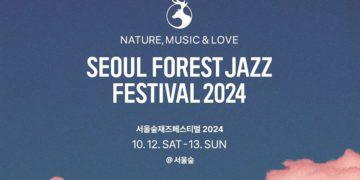
Experience Heartwarming Family Moment at Seoul Forest Jazz Festival 2024
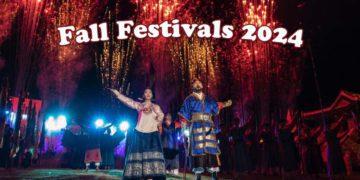
Popular 2024 Festivals You Must Attend This Fall in South Korea
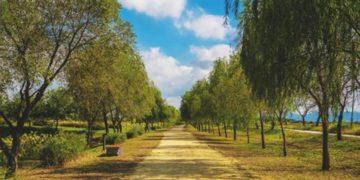
Experience the Beauty of the Korean Peninsula: Korea Dulle Trail
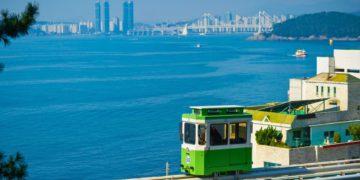
Haeundae Blueline Park Sky Capsule: Soar Above Busan

TESSAN Germany France Travel Power Adapter

Lonely Planet Korea 12

Korean Snack Box Variety Pack

OSULLOC Lovely Tea Gift Box Set
More from our network.

- Medical Tourism
FREE NEWSLETTER
Copyright © 2024 About Us| Terms of Use |Privacy Policy| Cookie Policy| Contact : [email protected]
Login to your account below
Fill the forms bellow to register
Retrieve your password
Please enter your username or email address to reset your password.

IMAGES
VIDEO